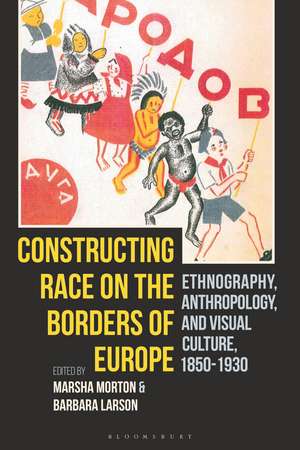Constructing Race on the Borders of Europe: Ethnography, Anthropology, and Visual Culture, 1850-1930
Editat de Marsha Morton, Barbara Larsonen Limba Engleză Paperback – 22 mar 2023
| Toate formatele și edițiile | Preț | Express |
|---|---|---|
| Paperback (1) | 149.02 lei 3-5 săpt. | +30.18 lei 5-11 zile |
| Bloomsbury Publishing – 22 mar 2023 | 149.02 lei 3-5 săpt. | +30.18 lei 5-11 zile |
| Hardback (1) | 573.71 lei 3-5 săpt. | |
| Bloomsbury Publishing – 5 mai 2021 | 573.71 lei 3-5 săpt. |
Preț: 149.02 lei
Preț vechi: 160.51 lei
-7% Nou
Puncte Express: 224
Preț estimativ în valută:
28.52€ • 29.66$ • 23.54£
28.52€ • 29.66$ • 23.54£
Carte disponibilă
Livrare economică 24 martie-07 aprilie
Livrare express 08-14 martie pentru 40.17 lei
Preluare comenzi: 021 569.72.76
Specificații
ISBN-13: 9781350233058
ISBN-10: 1350233056
Pagini: 304
Ilustrații: 12 colour and 63 bw illus
Dimensiuni: 156 x 234 x 22 mm
Greutate: 0.45 kg
Editura: Bloomsbury Publishing
Colecția Bloomsbury Visual Arts
Locul publicării:London, United Kingdom
ISBN-10: 1350233056
Pagini: 304
Ilustrații: 12 colour and 63 bw illus
Dimensiuni: 156 x 234 x 22 mm
Greutate: 0.45 kg
Editura: Bloomsbury Publishing
Colecția Bloomsbury Visual Arts
Locul publicării:London, United Kingdom
Caracteristici
Demonstrates how the sciences of early anthropology and ethnography were deployed in racial depictions in Eastern and Northern Europe, changing romanticized concepts of gypsies, Muslims, and others
Notă biografică
Marsha Morton is Professor of Art History at Pratt Institute, USA. A specialist in German and Austrian cultural history with a focus on interdisciplinary topics of art, anthropology, science, and music, her books include Max Klinger and Wilhelmine Culture (2014) and the co-edited anthology The Arts Entwined (2000). She is also a co-editor and contributing author to Visual Culture and Pandemic Disease Since 1750: Capturing Contagion (2023).Barbara Larson is Professor of Modern European Art History in the Art and Design Department of the University of West Florida, USA. She is author of The Dark Side of Nature: Science, Society and the Fantastic in the Work of Odilon Redon (2005) and lead editor of The Art of Evolution: Darwin, Darwinisms, and Visual Culture (2009) and Darwin and Theories of Aesthetics and Cultural History (2013).
Cuprins
List of PlatesList of FiguresList of ContributorsIntroduction, Marsha Morton (Pratt Institute, USA)1. From Folk to a Folk Race: Carl Arbo and National Romantic Anthropology in Norway, Patricia G. Berman (Wellesley College, USA)2. From "Northern Dweller" to "Distinguished Among His Race": The Transformation of the Nordic Colonial Subject, 1900-1935, Bart Pushaw (University of Maryland, USA)3. Decolonizing the Archive: Pia Arke and Stories from Scoresbysund, Alison Chang (Independent Curator, USA)4. Brigands and Virtuous Musicians: Representations of Roma ("Gypsies") as Oriental Other in the Eastern Part of the Habsburg Monarchy during the Eighteenth and Nineteenth Centuries, Robert Born (University of Leipzig, Germany) and Dirk Suckow (University of Leipzig, Germany)5. Leopold Carl Müller's Scenes from Egyptian Life: Ethnography, Race, and Orientalism in Habsburg Vienna, Marsha Morton (Pratt Institute, USA)6. A Hungarian Treasure Chest: The Art Colony at Gödöllo in Critical Perspective, Rebecca Houze (Northern Illinois University, USA)7. The Journey West: Gauguin, Philology, And the Celts of Brittany, Barbara Larson (The University of West Florida, USA)8. In the Beginning was the Image: Russian Ethnography and Colonial Photography in Turkestan, 1860s-1870s, Margaret Dikovitskaya (Independent Scholar, USA)9. "Children of the Narod: Early Soviet Children's Books' Racialization of Childhood", Marie Gasper-Hulvat (Kent State University, USA)10. From Sideshow to Portrait: The Ethnographic Vision of Christian Schad, Kristin Schroeder (University of Virginia, USA)11. Anthropological Histories and Techniques in Philip Scheffner's Films, Priyanka Basu (University of Minnesota, USA)Index
Recenzii
[T]he narrow focus of each chapter essay builds both a satisfyingly comprehensive and very specific picture ofthe social and cultural histories of countries at the Continental margins.
[T]his edited volume offers a number of very rich case studies from different geographies within Europe. The chapters merge primary and secondary sources and open up possibilities for a critical interpretation of visual materials through the history of ethnography and anthropology. As such, the edited volume should be of interest to an interdisciplinary readership interested in the construction of the other through visual depictions.
The uniqueness of the book and its fascinating contents lies [...] in the skilful juxtaposition of textual and visual sources in [the editors'] analyses.
Focusing our attention on the often contested and frequently porous "borders of Europe", this essential collection of essays complicates our understanding of how race, ethnicity, and national identity have been constructed and operationalized through art, design, and visual culture.
A compelling and timely collection of essays based on immaculate research that will alter the reader's critical understanding of the complex cultural-political engagement with subordinate ethnic groups in parts of Europe that have too long been marginalised by postcolonial discourse.
[T]his edited volume offers a number of very rich case studies from different geographies within Europe. The chapters merge primary and secondary sources and open up possibilities for a critical interpretation of visual materials through the history of ethnography and anthropology. As such, the edited volume should be of interest to an interdisciplinary readership interested in the construction of the other through visual depictions.
The uniqueness of the book and its fascinating contents lies [...] in the skilful juxtaposition of textual and visual sources in [the editors'] analyses.
Focusing our attention on the often contested and frequently porous "borders of Europe", this essential collection of essays complicates our understanding of how race, ethnicity, and national identity have been constructed and operationalized through art, design, and visual culture.
A compelling and timely collection of essays based on immaculate research that will alter the reader's critical understanding of the complex cultural-political engagement with subordinate ethnic groups in parts of Europe that have too long been marginalised by postcolonial discourse.
